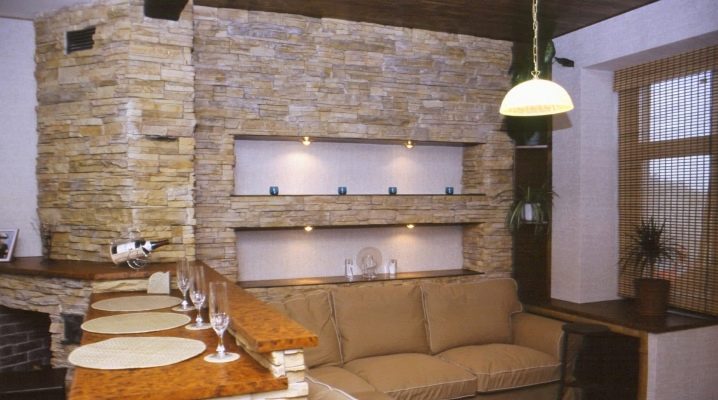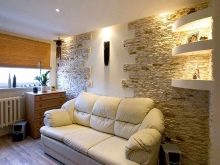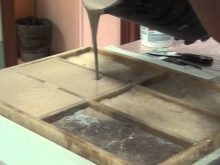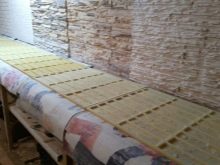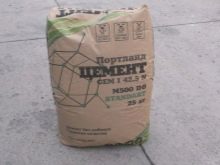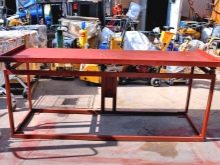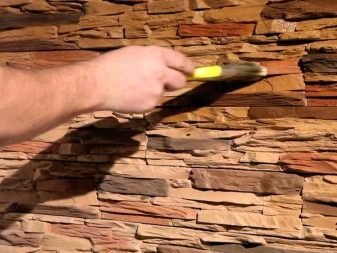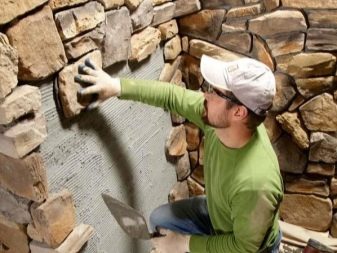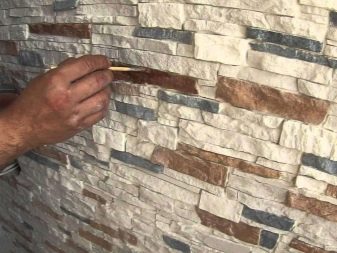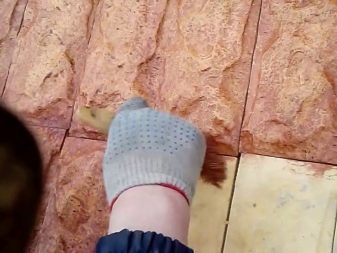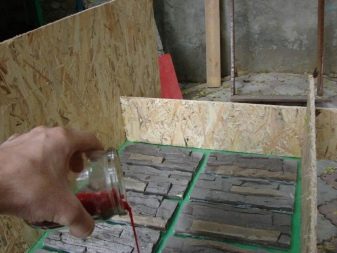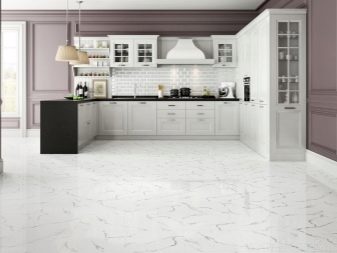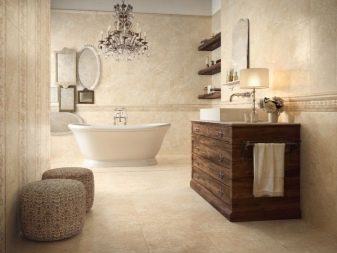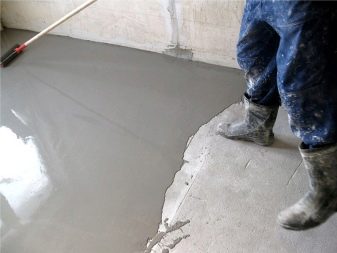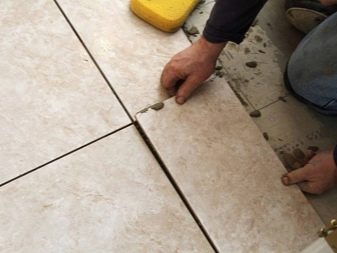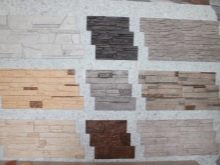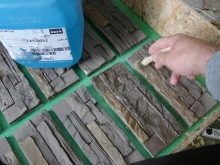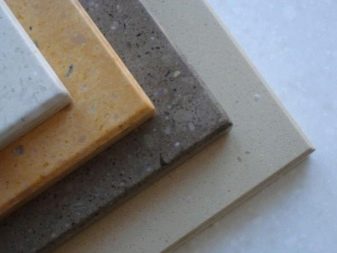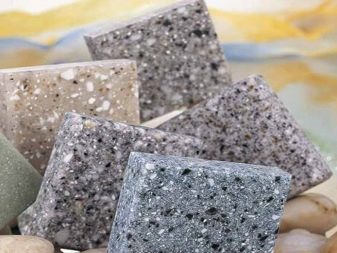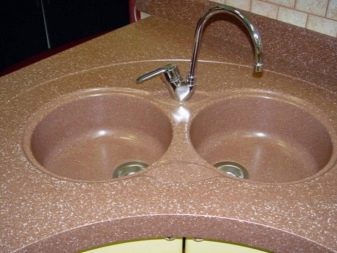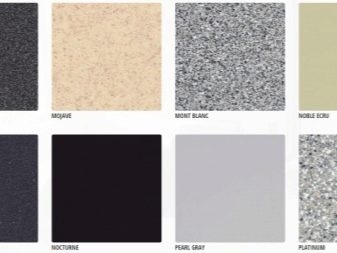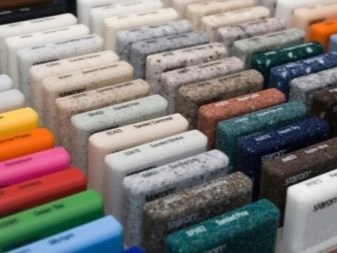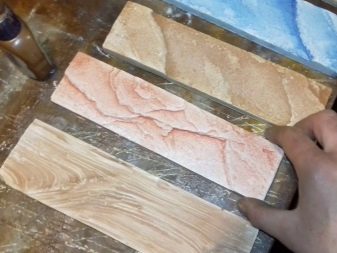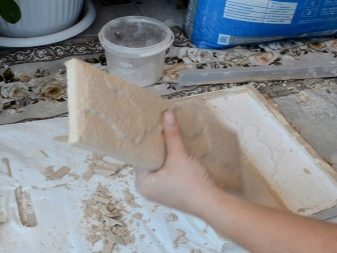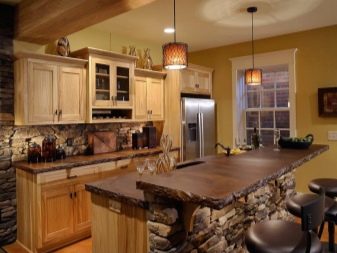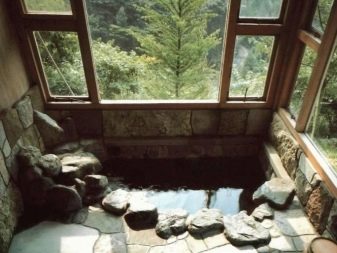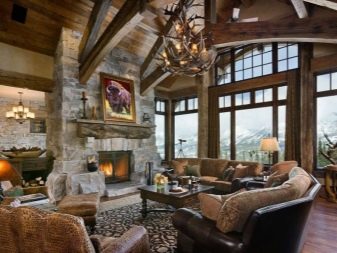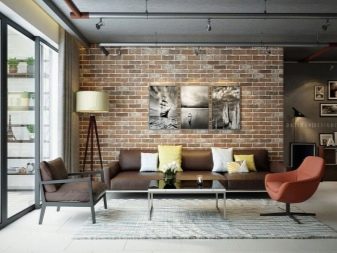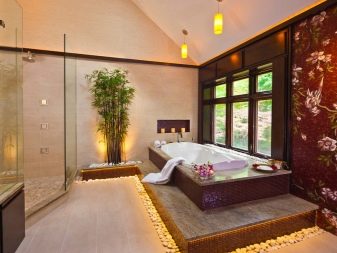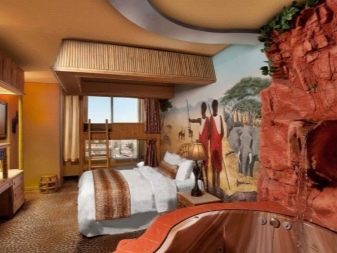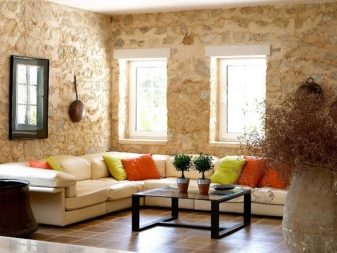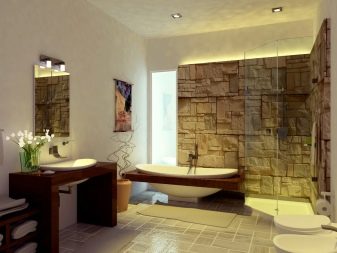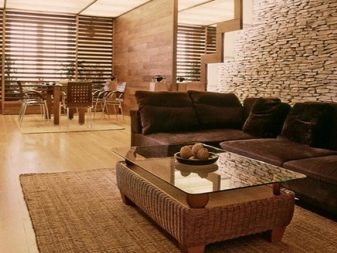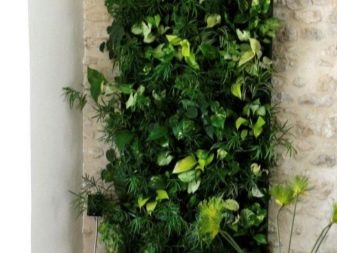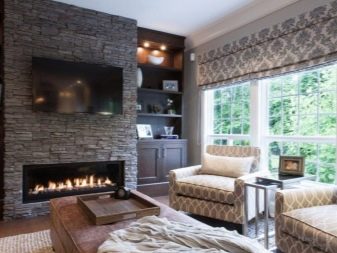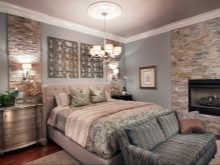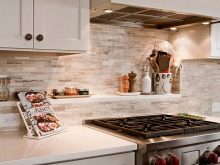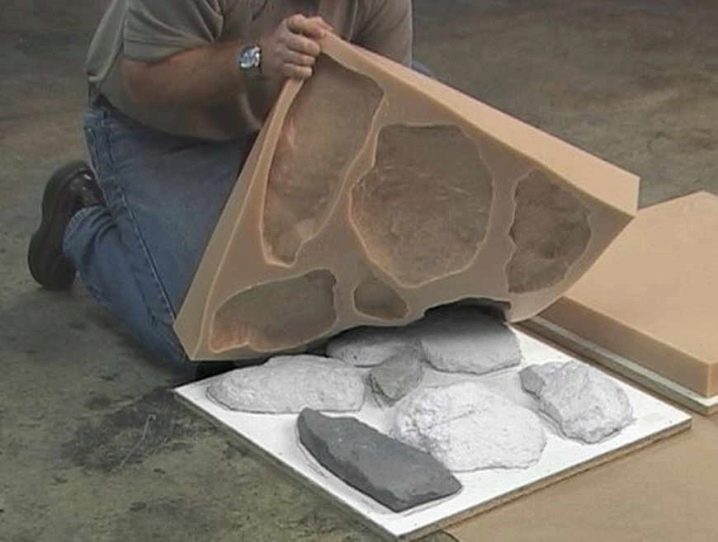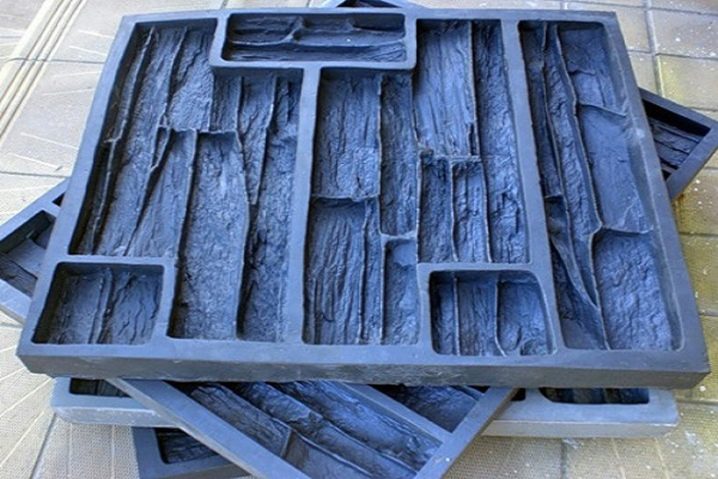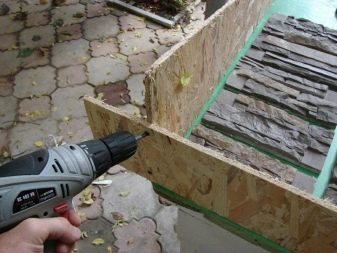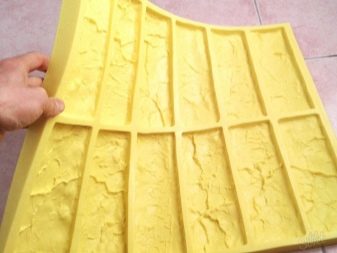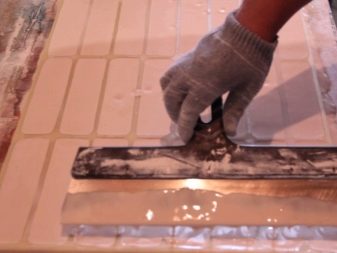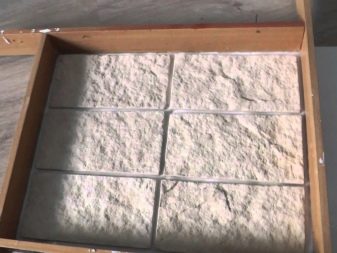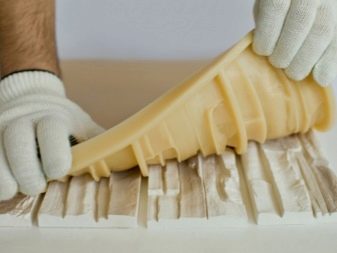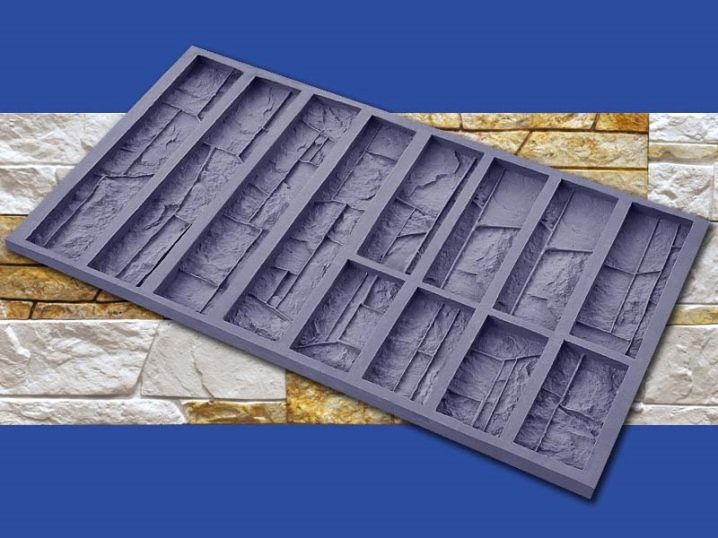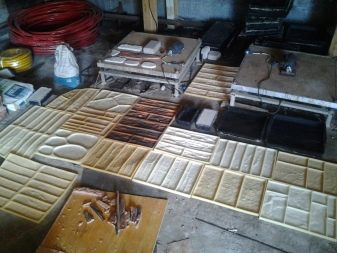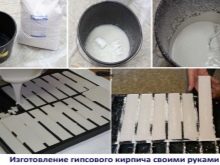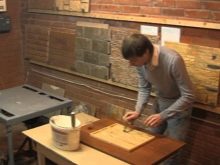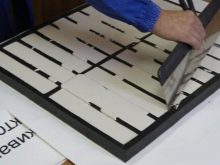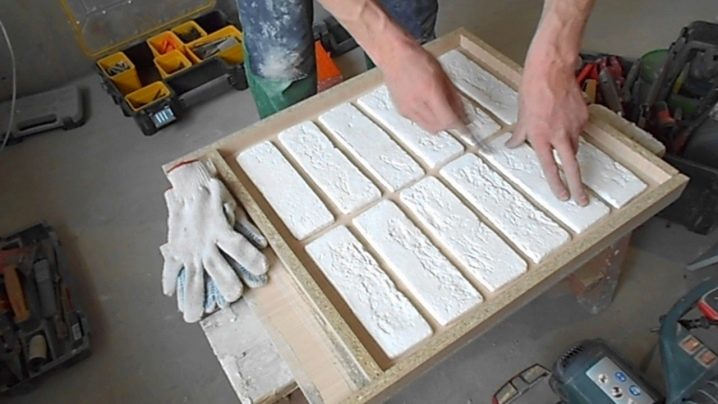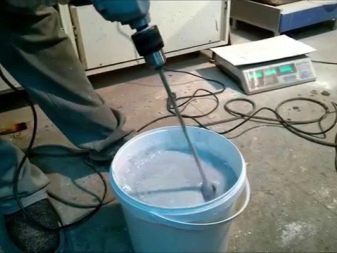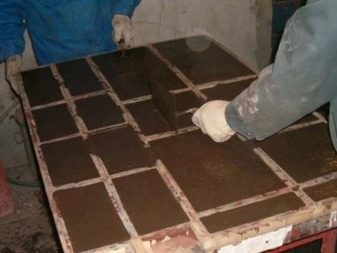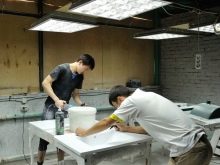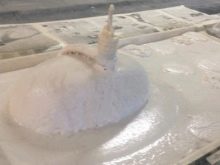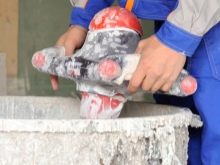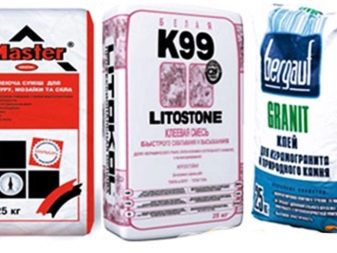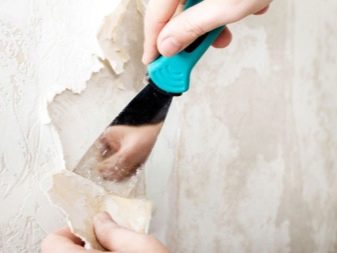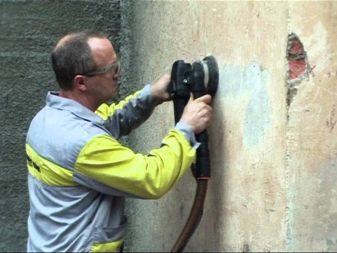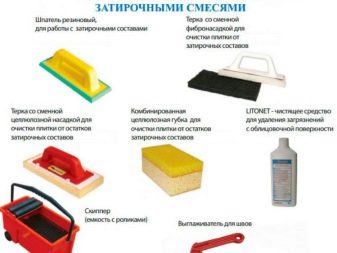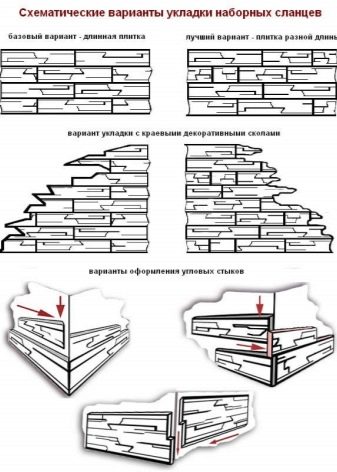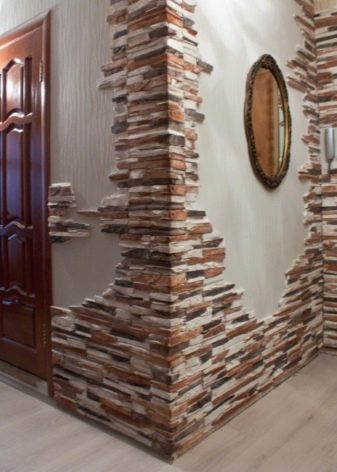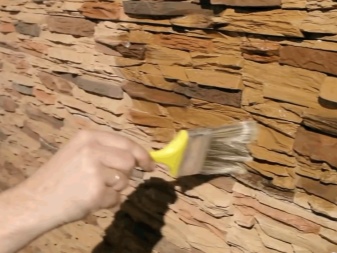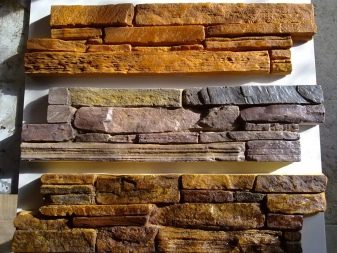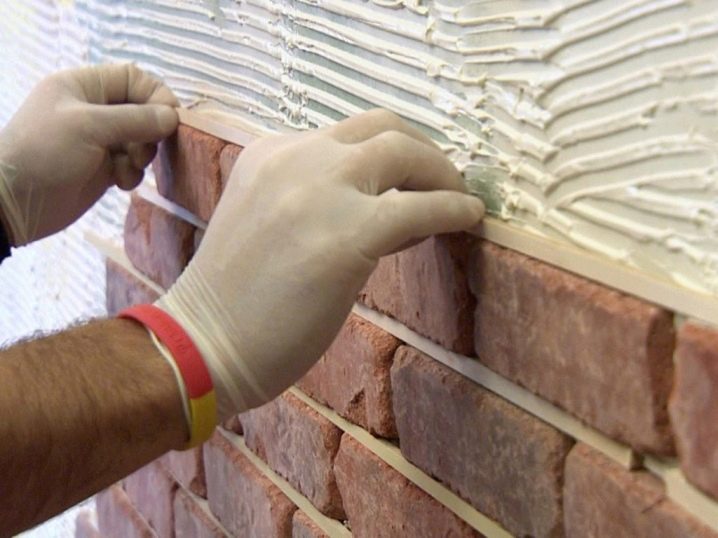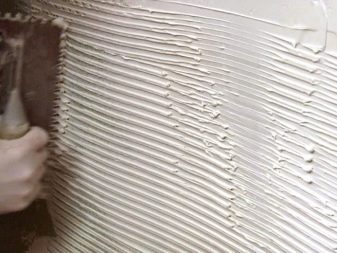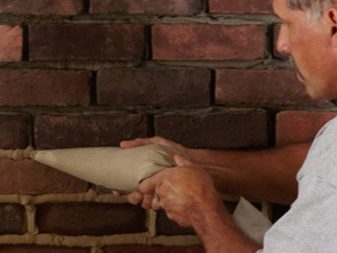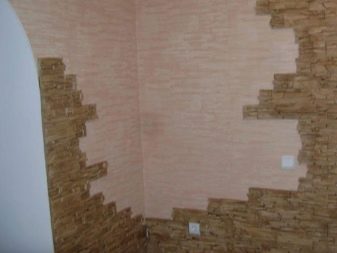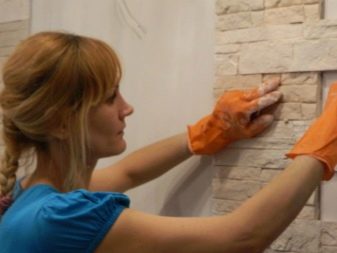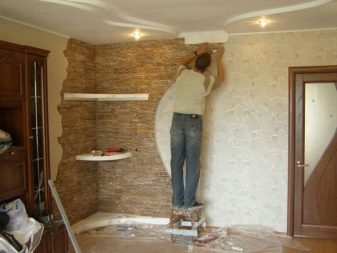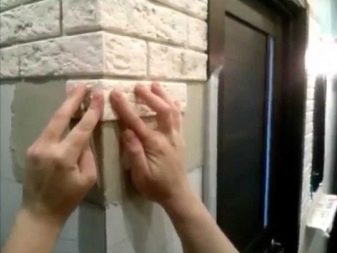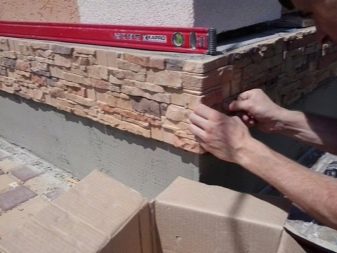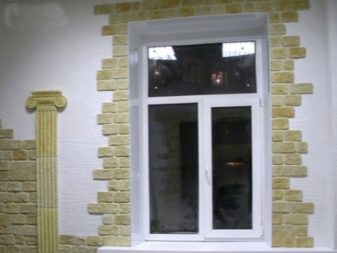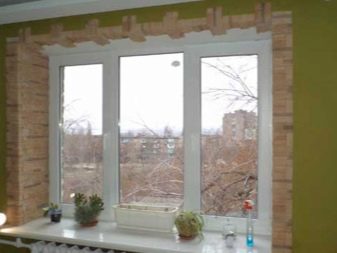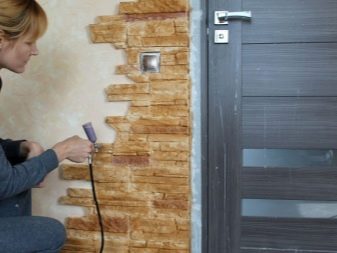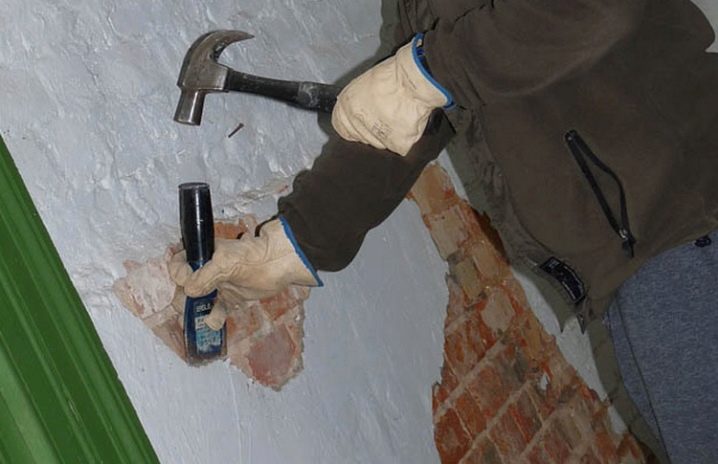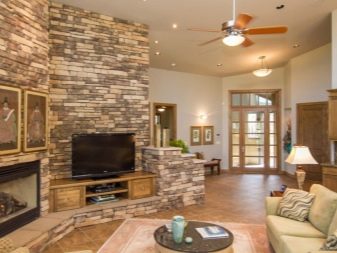Decorative stone for interior decoration: stylish design ideas
Surfaces of decorative stone often become decorations in the decoration of any house or apartment. This material is very popular and is presented in a wide variety on the modern market of finishing materials.
Many decide to use it as a primary or secondary coating. But in any case, it is important to take into account all the nuances of the decorative stone before its selection and purchase.
What it is?
Decorative stone is an artificial material that imitates natural stone. This coating is made in two ways: industrial and manual. These technologies differ little among themselves. In production, the material chosen for the stone is poured into a special mold made from the appropriate raw materials. It can be made of metal, silicone or plastic.Flooded composition is dried, often it passes through a special heat treatment. At the final stage, products are covered with various protective and glazed compounds.
And it is possible to make products for facing manually. This technology does not require large financial investments and implies the use of the next component as the main component - concrete. It is a standard material. And also it is necessary to choose the form into which the composition will be cast, because the future relief of the stone and the thickness of the facing layer depend on the shape. The forms of polyurethane are flexible, they are able to most accurately simulate the structure of natural stone.
From the materials you will need the following:
- cement mix brand M500;
- vibrating table;
- inorganic dyes, the number of which varies depending on the individual wishes regarding the design of the lining.
It is worth paying attention to the color of the selected cement. To create a dark decorative stone, use dark cement, while light raw materials are suitable for light veneering.
And also remember that To get a quality result, you need to use only fresh material., which has not lost its binding properties. It is worth paying attention that the material does not contain clay particles., and to ensure that the structure of the sand added during operation is as clean as possible.
Special features
Decorative coating of stone, like any other type of finish, has advantages and disadvantages that must be considered before buying or creating items.
The indisputable advantages of this type of lining include the following:
- the material is quite resistant to various mechanical stress during operation;
- it is simple to look after such covering. Depending on the particular raw material, it allows for various cleaning methods. But compared to wallpaper or paint, removing dirt from a decorative stone is an easier procedure;
- processing of artificial stone with special impregnations allows it to acquire the ability to repel grease and various kinds of contaminants;
- mold and fungus do not appear on a similar stone;
- compared to natural stone, this material is much cheaper.It has not so heavy weight;
- the uniformity of the structure of the facing coating gives it additional strength;
- decorative stone is quite simple to lay, because the side connecting to the base is ideally smooth in most cases;
- such material is not affected by temperature drops;
- As the basis for such a coating, almost any material can be used - from brick to wood and even concrete;
- despite artificial production, such a stone is considered an environmentally friendly material. It does not emit any substances harmful to health and the environment;
- in the event of damage, such a lining is easily restored by replacing the damaged element with another without destroying the entire structure;
- This material is a way to translate the original design. With the help of artificial stone on the walls are created drawings or elements that successfully complement the various concepts of the interior.
The material has a number of minuses that are not critical for most users, such as:
- connoisseurs of natural raw materials can feel the difference in tactile contact with an artificial surface;
- in comparison with simpler finishes, such as wallpaper or paint, artificial stone will cost more. And also the price is influenced by the material from which a specific type of decorative coating is made.
- there is a shorter service life of products in comparison with coatings from natural raw materials. But this indicator is more relevant for private homes.
Material
A very important criterion when choosing a decorative stone coating is the raw material from which it is made. Each material has its strengths and weaknesses that must be considered when studying the characteristics of the most popular species. Decorative stone can have various materials as the main component.
Porcelain stoneware
Porcelain tile is a material that includes high-quality clay, mixtures based on ground rocks and dyes of natural origin (mineral). Facing with an artificial stone made of porcelain stoneware can often be seen in the bathroom and in the kitchen, where there is a frequent change of temperature and an increased level of humidity is observed.
This raw material is characterized by a number of the following features:
- resistance to moisture;
- resistance to wear processes;
- ability to withstand high pressure on the surface;
- resistance to temperature extremes.
The disadvantages of raw materials include the following:
- the need for more thorough preparation of the base;
- The material is cold to the touch.
Gypsum
Gypsum finishing material is one of the most common.
This decorative stone has the following characteristics:
- the material is well breathable;
- it is able to maintain a certain level of humidity;
- gypsum is environmentally friendly;
- stones of this type are lightweight;
- universality - facing material is suitable for decoration of any premises: living room, kitchen, hallway, bedroom. It is also worth noting that with the help of such tiles is often made facing under the "brick".
The disadvantages include the fragility of such a stone. It can be easily damaged or broken directly in the process of lining, if you drop the plaster part on the floor from a great height.
Concrete
Concrete decorative stone is mainly used for exterior decoration, but sometimes it blends harmoniously with the interior of a house or apartment.
The advantages of this material include the following:
- high strength;
- long service life;
- over time, the color of the coating does not fade;
- the ability to withstand significant temperature drops;
- low moisture absorption.
Among the shortcomings can be noted that the lining of this material is not suitable for all styles of interior. And it also creates a fairly significant load on the walls due to the heavy weight of artificial elements.
Quartz
One of the most durable artificial stones is quartz. In addition to pigments, in its composition there is a natural mineral - quartz, as well as high quality polyester resin.
The material has the following qualities:
- resistance to temperature fluctuations;
- durability;
- strength;
- ease of care;
- resistance to the formation of mold and fungus.
Due to these properties, quartz decorative stone is used for interior decoration not only residential, but also public spaces, such as saunas and swimming pools.
Acrylic
Acrylic decorative stone has the following features:
- it is a hygienic material;
- such a stone has a long service life;
- bacteria are less formed on acrylic;
- it is possible to carry out polishing of this facing easily;
- glue seams on acrylic artificial stone, as a rule, invisible.
In residential areas, you can often find a similar finish in the bathrooms. From public premises, this material is preferred for medical facilities, cafes, restaurants and other places of public catering.
Liquid stones
A special kind are liquid stones. They are made on the basis of gelcoat.. It is a special composition that has a gel consistency. The main advantage of the material with such a flexible texture is the ability to create from it complex non-standard shapes.
Liquid decorative stones are used in various types of lining in addition to internal, sometimes they are even used for the manufacture of sanitary ware.
But compared to other types of raw materials, it does not have such good physical properties. Another disadvantage is the high cost of the components that are used to create this type of lining.
Slate
And also for decoration of various rooms are used ready-made decorative elements from slate. Such material is presented in the form of rectangular or elongated elements, most often located horizontally. Due to this lining, you can visually expand the area of the room.. But it should be borne in mind that to create a round pattern from such elements is very problematic.
Colors
The color scale in which the artificial stone is decorated is no less important than the material of its manufacture. The palette in which ready facing elements are presented mainly includes natural shades: beige, gray, brown, white. Naturally, tones can vary in degree of intensity. But not everyone needs a facing composition of decorative stone in such a color ensemble.
For lovers of the exotic or who want to create a special accent in the interior with the help of artificial stone, some manufacturers produce more catchy solutions. Their colors are: terracotta, yellow and even black.
If it is decided to independently manufacture the facing elements, it is worth calculating the amount of pigment needed to give the materialdesired color.
It must be remembered that the smaller the volume of the mixture will be diluted with color, so it will eventually be more intense. Therefore, for the beginning it is worth taking a trial amount of material for making stone and calculate the required proportions of the components.
If you want to change the shade of an artificial stone after its installation, you should use special coloring compositions that are sold in hardware stores. In some cases, it is appropriate combination of several colors in the same lining. As a rule, combine two shades, sometimes creating a small gradient. These tones should be closeso that the look of the entire coating looks harmonious.
Style and design
It is important that the selected type of artificial stone for decoration is combined with the interior of the room. It must be remembered that such interior design is not suitable for all styles. Depending on the chosen concept, the appearance of the decorative coating may be different.
- You can meet like japanese decor. As a rule, the details of artificial stone can be seen not on the entire wall, but only in areas.Such an element frames the shelves or niches in the walls. Used discreet, light colors. One should not deviate from this concept, since the entire Japanese style is generally focused on a minimalist concept.
- Country style involves the combination of masonry from artificial stone with wooden textures. An interesting relief on the stone surface is allowed. It is faced with similar material mainly fireplaces, which in the concept of this style are massive structures. Sometimes you can find this element even on furniture, for example, on the bar counter.
- Stone finish is very appropriate in hunting chalet style. In this case, masonry made out the whole wall. This solution looks very important in combination with wooden ceilings and hunting accessories. Laminate and carpets may be present on the floor.
- Chinese style The contrast between the bright color of the walls and the stone trim in natural colors is widespread. This peculiar accent “dilutes” the overall saturation of the interior and makes it truly original.
- African style is fairly free in terms of finishing. Often, a combination of incompatible colors and textures is permissible. You can make stone cladding of the entire wall or just some of its sections, create an ensemble of saturated colors, or combine natural shades of cladding with African prints.
- Particularly relevant is the laying of artificial stone under the "brick" towards loft. This design emphasizes the special, slightly coarse features of this style. Brick finish can be issued as all the walls, and their part. Allowed red, white or gray shade of decorative stone. You can also deliberately highlight the seams between the elements.
- In classic style welcome decoration with decorative stone fireplaces. In such pompous styles like Baroque and Rococo, it is permissible to use gypsum elements made of decorative stone, but in small quantities.
- In modern style decorative masonry perfectly combined with pictures of nature and large windows.
- In ethno style walls are decorated with decorative stone, most often with a not very catchy look.In this direction, texture is more important than color. And against the background of such walls will look great all sorts of ethnic accessories.
- Since decorative stone is perfectly combined with vegetation, it can often be found as an element eco style. Sometimes pots of flowers or climbing plants are placed in a niche decorated with stone cladding. In most cases, facing is rectangular or elongated, sustained in light shades.
In addition to the direction of the interior, you should pay special attention to the purpose of the room, where there will be a decorative coating of artificial stone. In each room, you can specifically beat this element of the interior.
- The first option facing in the hall there can be a fireplace or a wall around it. Thus, it is possible to designate the central element of the room. If the hall is separated from the hallway by an arch, then the decorative arch stone at the edges will be appropriate. You can combine stone elements with plants, giving a dynamic touch to the interior.
- In the hall the lower half of the wall is often trimmed with decorative stone, while special paints are used for the upper half. Sometimes with the help of a stone, a protruding corner of the wall is formed, and an unusual abstraction of decorative facing elements is created on it. Particularly interesting are the saturated stones on the light walls.
- On the kitchen with the help of such a lining an apron is most often drawn up. This element helps to zone the cooking area and the dining area if the two rooms are combined into one. And also it must be remembered that for the kitchen it is necessary to choose coatings with special impregnation or a layer of glaze that repels dirt and grease.
- Matt decorative stone of restrained shades will be very appropriate in the interior of the bedroom. He will not only adjust for relaxation, but also give aesthetic pleasure. Often plots of stone are located on the wall on the sides of the bed, they can be selected to match the accessories and paintings. In combination with a suitable lighting brick walls in the room to sleep will help to create a special atmosphere.
Mold making
Many users have a question about whether it is possible to independently make a mold for the ebb of a decorative stone. The answer to this question is positive.A DIY-made mold will save money and create ideal parameters for the material from which it is planned to make a facing stone in the future.
Before manufacturing, you need to decide on the desired type of form. The product can be uniform or complex.
The first type implies the presence of homogeneous matrices with small dimensions. This design does not require large costs of materials. But the complex version of the form is more convenient because it is capable of simultaneously producing several cladding products at once. This significantly affects the time to create a decorative stone. For the base of the matrix, in most cases, a relief tile is chosen. An alternative to it is often natural materials, such as stone.
Wood reliefs can also be used as bases and create unique relief.
As a formwork, materials such as wood or cardboard will be useful. With the help of wooden boards the box is being knocked together; an alternative is a box made of cardboard. The size of the template should exceed the parameters of the initial stone sample in width by about 15 mm, and in height - by 30 mm.
This technique is necessary to create a characteristic lumen between decorative items. As the main form can be used polyurethane or a sealing compound. Sealant, designed specifically for this purpose, is also sold in finished form. In its composition there are two components.
Silicone
Silicone forms are incredibly popular for self-manufacturing decorative stone. But there is a certain strategy and a number of nuances to which it is necessary to listen while using this method of making a decorative stone for interior decoration.
- Silicone base is recommended to purchase in finished form. In hardware stores you can buy buckets with the composition of the required volume.
- With the help of grease it is necessary to process the walls of the formwork.
- The sample that will be used as a template should be placed at the bottom of the structure and also treated with solid oil. This procedure will further contribute to the preservation of the shape of the products, as well as to the less problematic separation of the matrix from the base. In the case of gypsum samples, the bottom of the formwork should be covered with two layers of lacquer, and only after it dries should the work continue.
- In order to lubricate the spatulas and brushes for an even distribution of silicone raw materials, it is necessary to make a soap solution.
- It is necessary to evenly distribute the silicone composition, covering them facing sample. It is not necessary to allow the formation of airborne sinuses during the formation of the matrix.
- When the entire formwork is filled with silicone, it will be necessary to level its surface. This procedure is performed with a spatula.
- For some time the form is not touched, so that the sealant stiffens and completely repeats the outlines of the samples. Drying time is calculated depending on the thickness of the silicone layer. This substance on average freezes at a rate of 0.2 cm per day. On this basis, it is possible to calculate the amount of time required for the composition to completely solidify. The longer the composition will harden, the better and better the shape will be.
- After, it is necessary to separate the product from the formwork. And also should carefully remove the samples. For a more convenient separation of samples, the base is sometimes required to be slightly trimmed. If irregularities remain on the silicone form, they can be eliminated using the same composition.
Thus, it is possible to create a form with your own hands for the manufacture of decorative artificial stone, without any special effort.
But we must remember that the quality of work will depend on how many times you can use this product.
From different materials
When there is a ready-made form for creating artificial stone cladding, it is necessary to choose the material for its manufacture. Based on this choice, the features of the procedure itself will vary.
If for concrete the technique of making stone is rather simple, then when using other types of raw materials, special nuances are taken into account.
Gypsum
First of all, in this case, it is important to make the gypsum itself using the correct technology, taking into account that the rate of solidification of the material is quite high. It is important to consider the total amount of raw materials needed, as well as the number of forms into which it will be poured.. When all the calculations are done, you should prepare ingredients such as water, gypsum, sand and pigment of the chosen shade (if necessary).
Next, you need to follow the following algorithm:
- to mix the composition, pour water into a container prepared in advance;
- after starting to add gypsum powder. The ratio of water to the main component should be 6:10;
- to give the material strength, you must add sand. Its amount should be 10% of the total mass of the composition;
- the amount of coloring pigment must be calculated in advance. It depends on the intensity of the shade that you want to get. On average, the amount of dye varies from 2 to 6%;
- should make a lubricant for the form. It consists of turpentine and wax, taken in a ratio of 7: 3;
- the composition fits into the form and leveled with a spatula;
- An additional procedure for increasing the strength of finished products can be vibration treatment, which should be carried out immediately after pouring the mixture into the matrix;
- after a quarter of an hour, remove the frozen products from the mold and dry them completely outdoors. Since the gypsum material is not resistant to the effects of high temperatures, it cannot be processed by firing.
Acrylic
This material is relatively popular for the manufacture of decorative facing stone, which is used for interior decoration.
To create acrylic products, you must have on hand the following components:
- resin;
- hardener;
- grease (suitable both homemade, and ready);
- electric drill;
- powder copolymers.
The manufacturing process is as follows:
- it is necessary to mix the two components - hardener and resin in the ratio of 1: 5. This substance should be 25% of the total mass;
- the remaining 75% comes from a coloring pigment and a filler, which is a crumb of mineral origin. The features of the texture of the elements of the future coverage will depend on the size of fractions in the crumb, so you should pay attention to this detail;
- in order not to be mistaken with color, it is necessary to decide in advance on its intensity and calculate suitable proportions of the pigment;
- when the mixture is poured into molds, you must wait a day to harden it completely. After this time, the tiles will be ready and can be removed.
A special kind of artificial stone that can be created with acrylic is marble. Artificial marble is obtained by combining acrylic resin and marble chips, as well as the necessary coloring pigments.
Liquid stone
Gelcoat liquid stone is easy to create with your own hands. This type of lining is manufactured using the following technologies, which differ significantly from each other in the number and type of constituent elements:
- technology of creating facial makeup;
- creating a primer solution by kneading.
40% of the facial composition falls on gelcoat. It also requires 1% hardener and 7% accelerator. The remaining percentage is due to coloring pigment and mineral content. The composition is able to harden after a day. Half the gelcoat (20%) must be taken for the technology of primer mixing. Most of the mass of the solution is microcalcite - this is a special element, which accounts for 73% of the composition. The proportions of the substance for solidification and accelerator are similar to those of the facial composition.
What to glue?
For interior use glue, made in the form of a powder mixture, which must be diluted in water. Proportions and recommendations are usually indicated on the packaging of the composition. Alternatively, liquid nails can be used.. Although cement is a bonding material that is used for exterior cladding with decorative stone, some craftsmen mix this component with PVA glue and use it for interior work.
Preparatory work
To lay the stone at the highest level, it is necessary to prepare the surface in advance. It should be durable. And also an important factor is the evenness of the surface. Maximum permissible deviations for 1 m is 1 mm. This rule should be observed regardless of the variety of decorative stone that will be superimposed.
An important stage is the cleaning of the surface. It is necessary to remove old finishing materials from it. These most often include wallpaper, plaster and paint.
It is necessary to completely rid the surface of the smallest particles of dirt and debris. It is most convenient to remove the previous coating layer with a spatula.
After, you should plaster the surface. Depending on the weight of the future facing material, it is possible to provide the plaster layer with a special reinforcing mesh, which helps to withstand heavy loads and strengthen the foundation.
To enhance the adhesion of the coating to the plastered surface, it is necessary to coat it with a primer mixture.
There are compounds specifically designed for plaster. You need to make sure you have all the necessary materials for further work.
These include the following:
- glue;
- tool for applying a hydrophobic mixture;
- hydrophobic mixture;
- capacity for adhesive composition;
- mix for grouting;
- spatula, which will be applied glue;
- building level;
- crosses for seams.
Having at hand all this arsenal, you can begin to prepare the adhesive composition and marking the position of the finishing elements. In addition to the preparation of materials, you must also make a sketch. It should indicate the number of decorative elements, especially their location and area of the site on which they will be.
Particularly attentive to this process is to be approached if you plan to create on the surface a certain pattern or ornament of a decorative stone. When all the preparatory work is completed, you can begin the process of laying material.
Choosing and laying your own hands
In order for a room to acquire an interesting look, you must follow the following rules when choosing a material:
- you need to carefully inspect the material for lining when choosing. The presence of small patches and light streaks on the stones will be an additional advantage, since this appearance creates the maximum similarity of products with natural stone;
- if light blotches are the positive side, then spots on decorative stones are not at all desirable. They can spoil the entire look of the surface and even disrupt the design concept;
- It is worth paying attention to that there is no growth on the finishing material. They make it difficult to easily and reliably glue the material to the surface;
- An additional advantage will be the presence of a water-repellent layer on the material. If it is not, then it is desirable to apply it to the finished products independently;
- it is also necessary to correctly calculate the weight of the structure. Not all walls are allowed heavy facing layers. This factor must be considered to avoid unexpected repair costs in the future.
When the choice in favor of a particular material is made, you can begin to finish the selected space inside the room.
This procedure is easy to do yourself. To do this, follow the rules and nuances of laying products on a specific surface area.
Walls
At the first stage of the process, a glue base is applied to the walls. It is distributed using a spatula. The strip of glue should not exceed the thickness of the first row of decorative elements.Each stone must then be alternately applied to the surface and slightly pressed down. Excess adhesive composition should be immediately removed. If you want to place the parts end to end, then you need to glue them close to each other.
If you plan to leave the distance between the tiles, this can be done in the following ways:
- to create a wide seam, you must use strips of drywall;
- no less interesting to look at different sizes of drywall strips. They allow you to create thinner seams;
- sometimes use special crosses for this kind of lining, made of plastic.
When the solution dries, it will be necessary to remove the above elements.
Grout grout should be prepared in advance.. It is created by mixing a substance with a dye pigment and cement adhesive mastic. To apply this composition, you must use a sponge or a special gun.
If you do not have the necessary tools at hand, you can use an improvised tool such as a tight bag. On the one hand, the bag is completely cut, while on the other, only a small cut is made.The package is filled with a mixture of grout and a thin layer squeeze this component into the seams. When all seams are filled, it is necessary to wipe the seams with a foam sponge.
It is also important to remember that the putty putty after drying has a white color, and this solution is not suitable for all interior styles. Therefore, after the layer has dried, a special pigment should be applied to it so that the seams are more in harmony with the decorative stone and have a natural tint.
After drying the paint, a special protective varnish is applied to the stone parts. It is recommended to apply several layers of this coating on walls that are often touched during operation.
A separate option is the combination of decorative artificial stone with wallpaper. Many decide to stick such a lining on the surface of the wallpaper and thereby create a certain pattern or accent. But in this case you need to remember that the success of such a decision depends largely on the material of the wallpaper. Paper coatings soak when they come in contact with glue and lose almost all of their properties. Vinyl and non-woven coverings on contact with glue do not deteriorate so much, but nevertheless there is no exact guarantee that the stone will stay on a similar basis for a long time.
In order to avoid undesirable consequences when creating a combination of wallpaper and an artificial stone, when sticking wallpaper, leave those areas on which it is planned to lay the stone in the future.
You can also start finishing with stone, and only then glue the wallpaper. But in this case, those cladding elements that will border on the wallpaper will need to be glued after the wallpaper itself. It should be remembered that under all types of coating the basis should be taken not a concrete wall, but a clean, leveled and prepared surface.
Corners
The corner of the room is a great place to set the starting point for each row of decorative elements. It is better to glue the material, starting from the top row. This technique will help not to stain the adjacent parts.
To significantly simplify the process of facing the corner sections, you can purchase special elements made of artificial stone, made specifically for placement in the corner of the room.
It is necessary to take into account that such elements are more expensive than ordinary ones. Another option is self-cutting parts with a hacksaw or grinder.You can put the elements overlap, and then grind off the edges at a 45 degree angle. This option is great for decorative stone made of plaster.
Window
A very popular and interesting option is the finishing of window slopes with the help of a decorative stone. In this case, the window opening is emphasized in the interior, which makes its appearance non-trivial and favorably beats many concepts.
For windows sold special finishing stone, which has a small size and light weight, because the window opening can not be overloaded with an element such as cladding. The surface of the slopes before laying the stone must also be leveled and primed inside and outside, and the surface should not be reinforced with the help of a reinforcing mesh. The installation itself must start from the bottom of the slope., and the subsequent elements continue to mount only with reliable fixation of the lower parts. To lay the lining at the corners, it is necessary to cut the tiles from the ends at an angle of 45 degrees. The common name for this method of installation is monolithic.
Tips and tricks
Separate process of decoration of the decorative stoneis his painting. In addition to the addition of coloring pigments in the composition of the raw materials, use the method of painting the finished stone. It is possible to paint the coating even after its attachment to the surface. To carry out this procedure, it is necessary to use special iron oxide compounds.. They have a rather big price, but it is justified by the quality of products of this type.
The most acceptable method of applying this substance involves the use of the spray gun. But in case of its absence, it is possible to apply the composition with a brush, in this case the work will be more laborious, and it will take more time. The result of dyeing will be successful if the color of the elements of the decorative coating is lighter than the seams between them. It is not recommended to use more than three iron oxide coatings in the design of walls.. To make the decorative facing look the most natural, it is necessary to make the rows shift during the laying process. It should be remembered that in the same row preferred tiles of the same thickness.
If you want to remove the tile, you must first remove furniture and textile accessories from the room,located next to the decorative coating. It is worth starting the process from the top layer, since the collapse of decorative elements can occur. If there is a desire to save the products, then for dismantling you need to use a chisel and a hammer.
If the preservation of the material is not an important factor, the coating can be removed more quickly using a perforator.
Successful examples and options
Designers offer many interesting options for decorating surfaces indoors with decorative artificial stone.
If you want to focus on the fireplace in the living room, then the whole wall, near which this attribute is located, can be decorated with stone facing in the same style. It should be combined with facing material for the fireplace itself.
To give the room an interior of a certain brutality, you can create a contrast between the seams and the stone. This technique involves the use of non-flashy colors to cover the walls and ceiling.
Masonry looks great in a niche. If the apartment or house has an original layout, then the appearance of curved walls can be significantly diversified and emphasized with the laying of a decorative stone.
Facing from an artificial stone is an excellent assistant in room zoning. For example, if the loggia is connected to a room, then it can be interesting to arrange the transition from one part of the room to another using stone tiles.
With the help of decorative tiles you can decorate the walls of the bedroom, located on the second floor of a wooden house. Such a solution looks very interesting, because the textures of wood and stone perfectly harmonize with each other. And in combination with pastel-colored textiles, they form a rather unusual ensemble.
Choosing an artificial stone as a material for interior decoration, you can significantly diversify the appearance of your home, emphasizing its individuality. In addition, taking into account the above recommendations, you can arrange any room at home so that it will please the residents daily and give aesthetic pleasure.
How to lay the stone in the video below.
